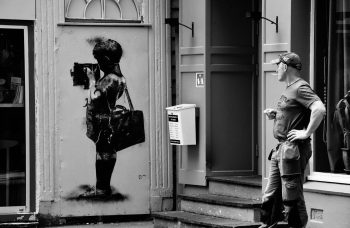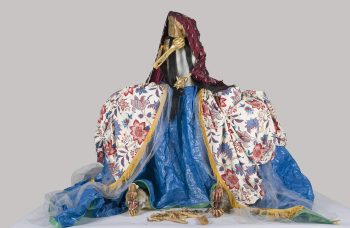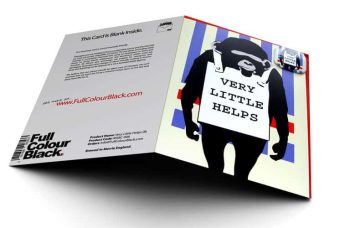Barnett Newman was born in Manhattan in January 1905, the son of Polish-Jewish immigrants who gave him a religious education. After completing high school, he enrolled in the University of New York to study philosophy. Throughout his studies, he often visited galleries and museums and soon began painting impressionist pieces. At the age of 25, while continuing to paint, he became an art critic and exhibition curator. In the midst of the world crisis of the 1930s, Newman reflected on painting as it related to political events. “Painting is over, we must all abandon it” he wrote at the start of World War II. After the events of Pearl Harbor, Hiroshima and the discovery of concentration camps, the powerlessness of painting seemed to be even more apparent to him. “I had to start back at zero, as if painting had never existed, which is another way of saying that painting is dead” he later stated in an interview given to Émile de Antonio in 1970. Figurative narrative painting and the formal painting of the first abstractionists no longer satisfied Newman who then committed himself to abstract expressionism. His first canvasses were indicative of his interest in cosmic and mythological events as evidenced by a painting entitled Euclidean Abyss(1946) which was his first major sale.

However, in 1948, Newman created Onement I which he considered to be his first significant piece. This vertical, rectangular canvas with a reddish-brown background was divided in the middle by a lighter red strip with uneven edges. The artist named this vertical part that separated the painting a “zip” in reference to a zipper because it divided and then rejoined the two parts of the canvas. Newman wrote about this piece in 1965, “I realized that I had made a statement that affected me and which was, I think, the start of my present life, because from that moment I had to abandon any relationship to nature such as it was perceived”. Following that discovery, Newman stopped working as a critic in order to devote himself to painting and to work on other versions of Onement. In 1950, he created a piece with unusual dimensions. Simply called The Wild, this canvas was 4.1 cm long and 243 cm high and displayed a copper band about 2 cm wide on a light blue background. With this piece, the artist proved that the most important feature of his paintings was the famous “zip” and not the relationship between the coloured surfaces. He also showed that what was important to him was not a painting’s size but rather its scale as he acknowledged in an interview given in 1966: “I think that it [The Wild] is as big as anything I have ever painted. It all has to do with the issue of scale and scale is a question of feeling”. Like many abstract expressionist artists, Newman was not trying to make the largest paintings imaginable but instead to create a life-size space that enabled spectators to actually enter inside his paintings. Sometime later, Newman made his trademark “zip” by producing his first piece of sculpture entitled Here I, which subsequently generated several variations. These pieces, free from the canvas, reinforced the notion that the “zip” is not limited to relationships within the medium but open to the entire space.

In 1957, Newman suffered a heart attack. This incident led to a new artistic phase which began in 1958 with a series of paintings called The Stations of the Cross. The artist created 14 paintings in alluding to the 14 stages of suffering of the Passion of the Christ. The series featured abstract pieces some of which were made of extremely defined zips while others were frayed paints on untreated canvasses and did not even represent the stations. The idea did not immediately come to Newman as he explained in an interview, “I started these pieces, eight years ago, in the same way that I began all my work, by painting. It was through painting (it was after the fourth) that I realized that I had achieved something special here. At that moment, the intensity that I felt in these paintings made me think of the stations of the cross”. This series’ use of black and white shades contrasts with Newman’s final pieces which since 1966 had started to incorporate primary colours, the most famous being Who’s Afraid of Red, Yellow and Blue?. It was also during this period that Newman started working on producing a monumental sculpture called Broken Obelisk whose triangular structure also gave him the idea of creating triangular paintings. These triangular pieces, still separated with a “zip”, alternated between bright (Chartres, 1969) and dark colours (Jericho, 1969), representing Newman’s first experiments with this technique before finally succumbing to a heart attack in July 1970.

Too abstract for the expressionists and too expressionist for the abstractionists, his paintings were, like his “zip” trademark, a never-ending search for balance as he himself stated. Newman wanted his paintings to be the place of communion of the spectator with himself and with others. “I hope that my painting can give everyone, as it did for me, the feeling of one’s own totality, of one’s own separate existence, of one’s own individuality and at the same time one’s connection to others, which also exists separately”, he wrote. He was one of the rare artists of his generation to refuse to participate in the government’s program of aid to artists (Work Progress Administration) believing that this money constituted isolationism and gave abstractionism a social perhaps even political potential. He also wrote: “I’ve been asked what my paintings really have to say about society and about the world situation. My response has been that if my work was properly understood, it would signify the end of capitalism and of the totalitarianism of the State. My work, in terms of social impact, suggests the possibility of an open society, of an open world and not of a closed institutional one”.






